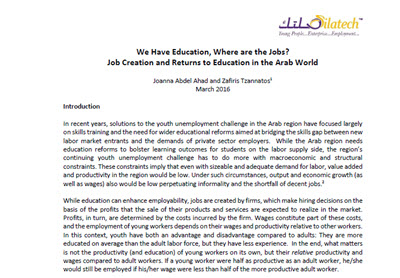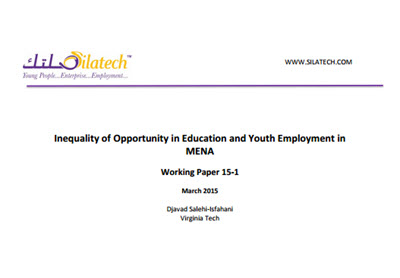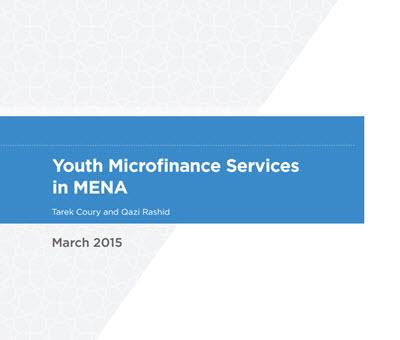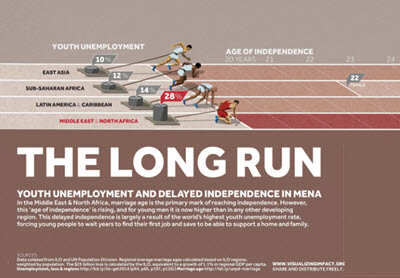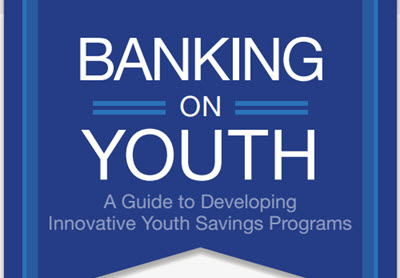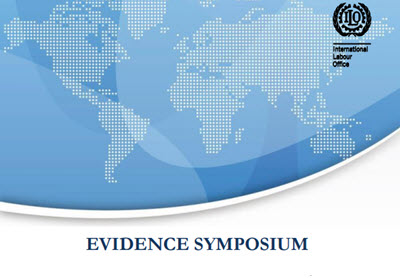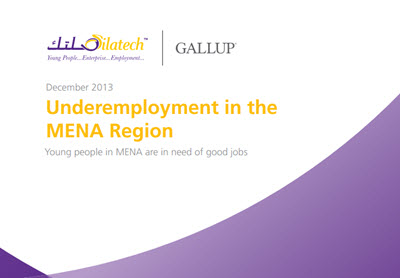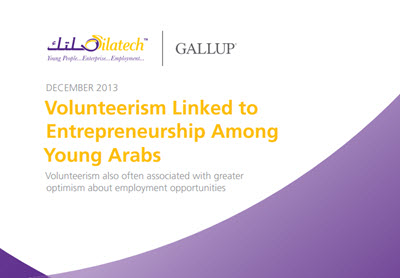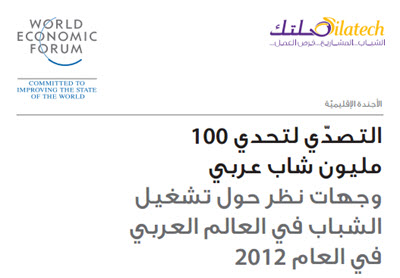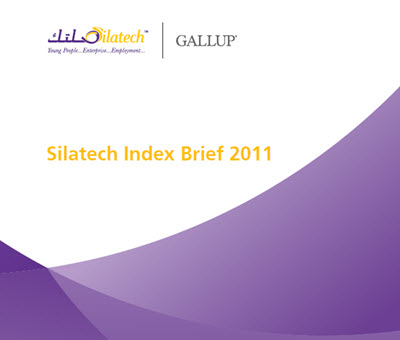-
Job Creation And Returns To Education In The Arab World
Mar 01, 2016This brief provides an analysis of returns to education in the Arab world compared with other regions, the effect this has on job creation for youth, and policy ramifications.Read More -
Inequality Of Opportunity In Education And Youth Employment In Mena
Mar 29, 2015This paper updates the earlier literature on youth transitions from school to work in MENA countries in light of new evidence on inequality of opportunity. Inequality of Opportunity in Educationand Youth Employment in MENA Working Paper 15-1 Abstract This paper updates the earlier literature on youth transitions from school to work in MENA countries in light of new evidence on inequality of opportunity. It argues that the discussion of transitions based on the experience of the “average youth” miss significant variation in experiences of youth from different social and economic backgrounds, and that these differences should be taken into account in designing policies to facilitate youth transitions. The evidence reviewed in this paper shows great variation across the region in all types of inequality of opportunity. The evidence also shows that inequality of opportunity in several countries is very high. In these countries the quality of the family and community environment in which a child grows up matters greatly for the likelihood of ever entering school and reaching the secondary level, achievement in math and science, and for the quality of jobs in which they end up as adults. The paper discusses some of the reasons behind the high levels of inequality of opportunity, in particular the methods of national testing that reward a narrow range of skills, which leads to lower equality of opportunity.Read More -
Youth Microfinance Services In Mena
Mar 01, 2015Analyzing the responses of 43 microfinance institutions surveyed in 10 countries across the Arab world, this report provides a description of MFIs’ level and type of provision of youth financial and non-financial services, attitudes toward youth, and assistance required to increase youth outreach. While recent reports illustrate the severity of youth economic and financial exclusion in the MENA region, little is known about the financial and non-financial services specifically provided by MENA financial intermediaries – such as microfinance institutions (MFIs) – to Arab youth. Analyzing the responses of 43 microfinance institutions surveyed in 10 countries across the Arab world, this report provides a description of MFIs’ level and type of provision of youth financial and non-financial services, attitudes toward youth, and assistance required to increase youth outreach. The key findings of the survey center on how MFIs view youth in terms of market prioritization, serve the market segment, and assess the performance of their youth loan portfolios against those of older adults.Read More -
The Long Run: Youth Unemployment And Delayed Independence In Mena
Nov 02, 2014With the highest youth unemployment rate in the world, 28% of the MENA’s youth labor force (15-24 years old) is without a job. This means that over 7 million young Arabs must wait longer to gain their first professional experience and are unable to start saving for a home and marriage and ultimately begin on a path toward independence. "The Long Run" is an infographic jointly produced by Silatech and Visualizing Impact. Youth unemployment and its effect on delayed independence - the focus of this infographic - nonetheless directly and indirectly contribute to the region’s sustained troubles. With the highest youth unemployment rate in the world, 28% of the MENA’s youth labor force (15-24 years old) is without a job. This means that over 7 million young Arabs must wait longer to gain their first professional experience and are unable to start saving for a home and marriage and ultimately begin on a path toward independence. In addition to taking a social and financial toll on millions of young people, the high youth unemployment rate adversely affects the region’s economies. It is estimated that the region’s Gross Domestic Product (GDP) could increase by $25 billion by 2018 if the youth unemployment rate is reduced by half. “The Long Run” is an infographic that comes as the result of a collaboration between Silatech and Visualizing Impact. Visualizing Impact is a creative design studio that focuses on social issues.Read More -
Banking On Youth: A Guide To Developing Innovative Youth Savings Programs
Oct 28, 2014This publication is a guide for deposit-taking institutions in any stage of youth savings program development—from those simply exploring the possibility of introducing youth savings, to those already offering youth products but looking for new ideas and strategies to improve performance. It presents Women’s World Banking’s approach to designing, implementing, and evaluating savings programs for low-income youth, based on its experience providing technical assistance on programs launched at three financial institutions in three countries. The publication covers the following topics: Creating the Business Case for Youth Savings, The Program Design Stages, The Implementation of Youth Savings Programs—from Pilot to Roll-out, and The Program Evaluation for Youth Savings Programs. This guide was originally published in English by Women’s World Banking. Silatech produced the Arabic version of the guide.Read More -
Evidence Symposium: Increasing Youth Productivity In The Middle East And North Africa
Mar 30, 2014This proceedings report summarizes findings of the Doha Evidence Symposium, held March 6-8, 2014, in which practitioners, academics and policy makers discussed the evidence for "what works" in terms of programs and policies aimed at improving employment outcomes for young people. On March 6-8, 2014, Silatech co-sponsored the “Evidence Symposium: Increasing Youth Productivity in the Middle East and North Africa,” which was hosted by Georgetown University – Doha. Other sponsors included the International Labor Organization, the Abdul Latif Jameel Poverty Action Lab and the Arab Urban Development Institute. The Symposium brought together 93 practitioners, academics and policy makers to present and discuss the evidence base for "what works" in terms of programs and policies aimed at improving employment outcomes for young people. This final report provides an overview of the issues raised during the Symposium, with the aims of catalyzing more partnership among donors, policy makers and researchers with the goal of advancing our knowledge of what works, and what does not, in promoting employment and entrepreneurship for young people in the Arab world. The full report can be accessed here.Read More -
Silatech Index Brief: Underemployment In The MENA Region
Dec 30, 2013Conducted with Gallup, this brief compares reported unemployment as well as underemployment in the Middle East and North Africa (MENA) region to other major regions worldwide in 2012. It specifically focuses on reported levels among young people ages 18-29, who are most likely to be in or attempting to enter the labor force of their respective countries. The brief compares underemployment levels within the MENA region across different age groups and educational attainment levels. Key Findings The MENA region has the highest unemployment rate for young people worldwide. Underemployment in the MENA region is among the highest found in regions around the world. Globally, MENA youth have among the highest underemployment rates compared with peers in other regions. Young women in the MENA region have the highest unemployment among young women worldwide.Read More -
Silatech Index Brief: Volunteerism Linked To Entrepreneurship Among Young Arabs
Dec 28, 2013This brief addresses links between volunteerism and entrepreneurship, as well as other questions regarding the current state of volunteerism in the Arab world, including where 15- to 29-year-olds are most likely to volunteer for organizations as well as who these young volunteers are. Volunteerism has always been an important part of civic, cultural, and economic life in the Arab world. It has taken on even more significance since the 2011 uprisings. In some countries, civil society is playing a larger role than ever before — and in others, it is playing an important role, or a different one, for the first time. All countries in the Arab world, however, stand to benefit from providing young people with more chances to volunteer, with an emphasis on service-oriented opportunities that include skills training, educational assistance, and community development. Gallup finds links between volunteerism among young people and entrepreneurship that suggest such an emphasis could support much-needed job creation in the Arab world. Young people who volunteer are generally more likely than those who do not to say they have access to the training, money, and partners they would need to start a business. This brief addresses those links and several other questions regarding the current state of volunteerism in the Arab world, including where 15- to 29-year-olds are most likely to volunteer for organizations as well as who these young volunteers are. The answers are based on survey results from 19 Arab world countries and areas plus the Somaliland region of Somalia in 2011. This information can provide policymakers with new insights about how volunteer programs contribute to healthy, prosperous societies. Key Findings Young people in the Arab world are among the least likely worldwide to say they volunteered their time to an organization in the past month. Young men and women who volunteer are more likely to know someone they would trust enough to start a business with and to have access to the training and money to start a business — both factors crucial to entrepreneurship. These relationships are significant across countries at various levels of per-capita GDP. Volunteerism varies among high-income, middle-income, and low-income countries. Young people in all middle-income countries are less likely than average for the Arab world to say they have volunteered their time to an organization in the past month. Awareness of social organizations, nongovernmental organizations (NGOs), and charities that offer opportunities to serve the community is highest among young people in high-income Arab countries. However, awareness of opportunities to serve does not always translate into higher volunteerism rates. Young men and young women in many Arab countries — particularly middle-income countries — are just as likely to say they volunteered their time to an organization in the past month.Read More -
Addressing The 100 Million Youth Challenge
Dec 15, 2013Originally compiled in English by the World Economic Forum’s Global Agenda Council on the Arab World, the Arabic version of this report has been produced by Silatech. The report is a collection of essays published to provide a direct response to the Arab world’s uniquely high level of youth unemployment. "Addressing the 100 Million Youth Challenge, Perspectives on Youth Employment in the Arab World in 2012" is a collection of essays by members of the World Economic Forum Global Agenda Council on the Arab World. The report is published to provide a direct response to the Arab world’s uniquely high level of youth unemployment in order to help sustain the early economic gains in terms of political stability and economic promise that have followed in the wake of the Arab Spring. These cover the following topics: social innovation and new approaches to the employment challenge, determinants and challenges of the current youth unemployment situation, female economic empowerment, building Arab civil society to promote economic growth, access to credit, the economic agendas of Arab Islamist parties, education for employment, and a paradigm shift in government – from creating jobs to enabling job creation. Originally compiled in English by the World Economic Forum, this Arabic version has been produced by Silatech. For the English version, click here.Read More -
Silatech Index Brief: July 2013
Nov 19, 2013Conducted with Gallup, this Silatech Index Brief focuses on three key elements needed to unlock opportunities for young people in the Arab world: Access, Policy, and Mindset. In 2009, Silatech and Gallup introduced a Silatech Index as a way to benchmark levels of economic opportunity and inclusion among Arab Youth and track changes over time. Index scores for 2012 include results from 19 Arab countries and the Somaliland region of Somalia. In many countries, index scores have changed, either moving up or down, underscoring the dynamic nature of the index dimensions and the effects of evolving economic, societal, and political events in the region. As the perceptions of young Arabs grow more positive or negative over time, the Silatech Index measures progress on the ground. This report also provides an analysis of the factors that are most predictive of a higher Silatech index in each measured country. The index focuses on three key elements needed to unlock opportunities for young people in the Arab world: Access, Policy, and Mindset. Access examines young people’s access to demand-driven and market-oriented skills training and job placement services and to improve micro-, small-, and medium-sized enterprises’ (MSMEs) access to capital, business development services, and markets. For young people to succeed in finding gainful employment, they need access to skills training, job counseling, and placement services linked to market requirements. Research shows, however, that given the regional youth bulge, there will not be enough jobs to employ those young people entering the labor market even if they have the type of skills employers desire. This fact drives the need to focus on addressing the needs of young entrepreneurs to access financial products and services, business development services, and links to corporate supply chains and national, regional, and global markets. The provision of such support serves to enable their growth and expansion such that they become the engine of local economic growth and job creation. Policy examines the adoption of enabling policies to stimulate increased employment and economic opportunities for young people and social inclusion. Leaders must shape government policies to improve the competitiveness of the labor market, the strength of the business environment, and the overall employment and economic opportunities for young people. Mindset examines society’s recognition of and support for young people’s contributions to economic and social capital and youth’s understanding of the realities of working life. Research shows that many factors help or hinder young people’s pathways to employment and social inclusion. It is important to build on traditional values to improve attitudes toward various types of work, gender norms, and family and community support that accelerate young people’s meaningful engagement in society and the economy.Read More

